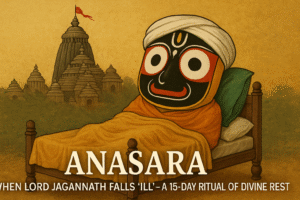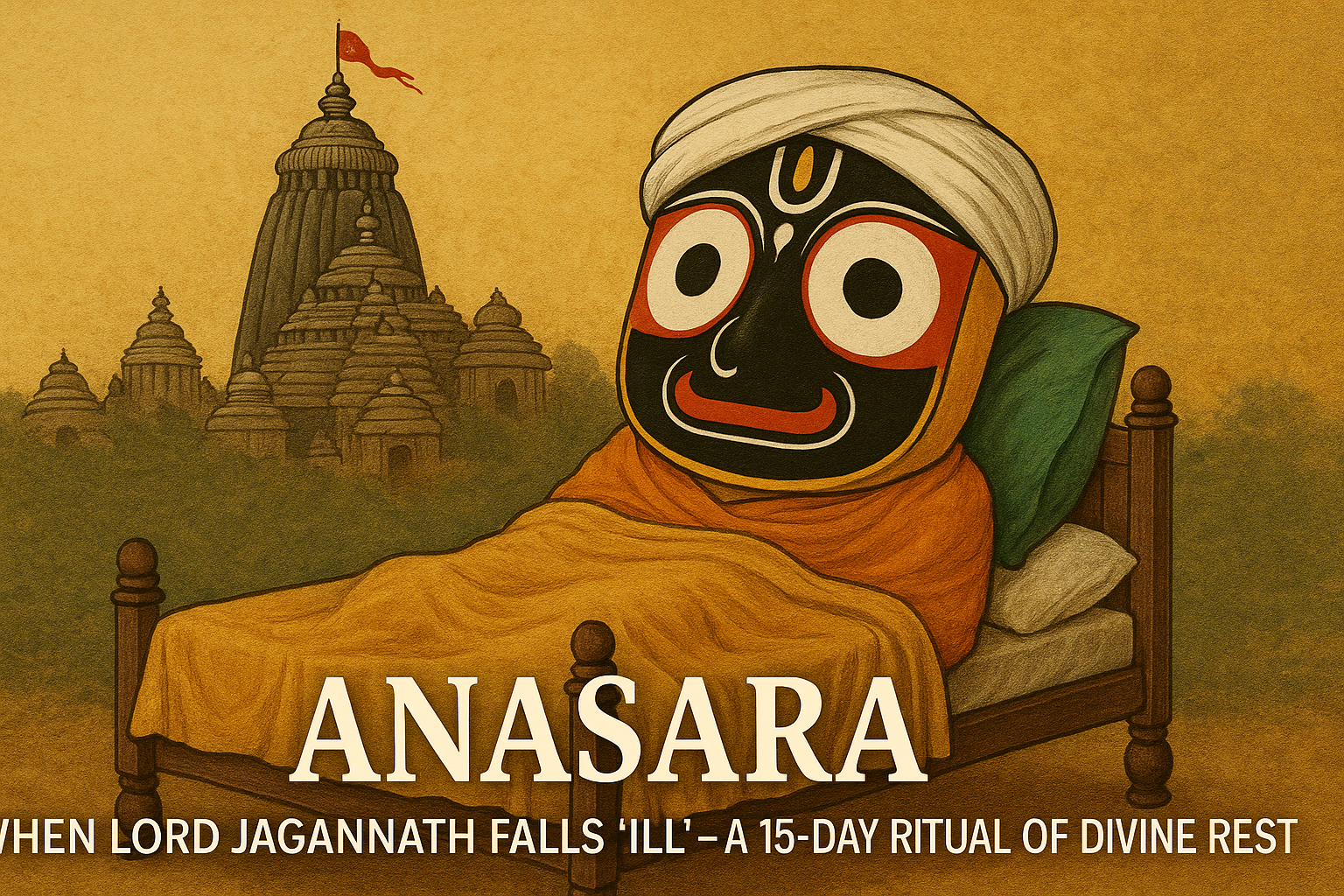
Introduction
Every year, in the sacred town of Puri, Odisha, a deeply mystical and lesser-known ritual unfolds before the grand Rath Yatra (Chariot Festival). This period, known as Anasara, marks the time when Lord Jagannath, along with his siblings Balabhadra and Subhadra, is believed to fall “ill” after the elaborate Snana Purnima (holy bathing ceremony). For 15 days, the deities retreat from public view, symbolizing divine rest and healing.
But why does the Lord of the Universe need rest? Let’s delve into the divine mystery of Anasara and explore the spiritual, mythological, and cultural significance of this unique tradition.
What is Anasara?
‘Anasara’ is derived from the Sanskrit word ‘Anavasara’, which means “not to be seen.” After being bathed with 108 pots of sacred water on the day of Snana Purnima, the wooden deities are said to catch a fever. As a result, they are taken into seclusion inside a secret chamber of the Jagannath Temple, known as the Anasara Ghar, to recuperate.
During this period:
The idols are not available for darshan (public viewing).
Priests perform special healing rituals and offer medicinal preparations like Dasamula.
Devotees believe this is a time of deep divine transformation and rebirth.
Table of Contents
Mythological and Spiritual Significance
According to legend, the intense bathing ritual on Snana Purnima weakens the wooden idols, who are believed to be imbued with living consciousness. Just like humans fall sick after exposure to the elements, the gods too are nurtured like beloved family members.
This tradition humanizes the deities — reminding devotees that God shares our joys, sorrows, and even physical ailments. The Anasara period symbolizes:
Restoration and inner healing
Transition from one form to another
The balance of devotion and patience

What Happens During Anasara?
Seclusion of Deities: The deities are moved to a special chamber inside the temple and remain hidden from devotees.
Healing Rituals: Herbal medicines and food are offered to help the lords “recover.”
Alarnath Darshan: During this time, devotees visit the nearby Alarnath Temple in Brahmagiri to have darshan of Lord Vishnu, as a symbolic replacement of Lord Jagannath.
Chitrakara’s Role: A special group of temple artists repaint and restore the divine features of the idols in a process called ‘Netrotsav’, preparing them for public appearance during Rath Yatra.
The Culmination: Netrotsav and Rath Yatra
On the 16th day, a special ritual called Netrotsav (festival of the eyes) is held where the deities are believed to regain their divine sight. This is followed by Rath Yatra, the world-famous Chariot Festival, where millions gather to witness the deities come out of the temple and ride massive chariots to the Gundicha Temple.
Why Anasara Matters
In a world obsessed with speed and visibility, the Anasara period quietly teaches us the value of rest, retreat, and renewal. It shows how even the Divine needs time to rejuvenate — offering a powerful reminder to humans to honor their own cycles of rest and healing.
Conclusion
The tradition of Anasara adds a mystical depth to the spiritual landscape of Jagannath Puri. This 15-day observance not only strengthens the bond between the devotees and the divine but also emphasizes a universal truth — that divinity lies in simplicity, care, and rhythm.
Next time you hear about the grand Rath Yatra, remember — it is preceded by a quiet, sacred pause called Anasara, when even the gods rest before embarking on their journey.

(Frequently Asked Questions) on Anasara: When Lord Jagannath Falls ‘Ill’ – A 15-Day Ritual of Divine Rest:
- What is Anasara in the Jagannath Temple tradition?
Answer: Anasara is a 15-day period after Snana Purnima during which Lord Jagannath, Balabhadra, and Subhadra are believed to fall ill and are kept in seclusion inside the temple for rest and healing. The deities are not available for public viewing during this time.
- Why do the deities fall ‘ill’ after Snana Purnima?
Answer: After being bathed with 108 pots of holy water during the Snana Purnima ritual, it is believed that the deities catch a symbolic fever, requiring rest and herbal treatment, just like human beings.
- Where are the idols kept during Anasara?
Answer: The idols are kept in a special chamber called Anasara Ghar (the secluded room) inside the Jagannath Temple, away from the public eye, where healing rituals are performed.
- Are devotees allowed to see the deities during Anasara?
Answer: No, the deities are not available for darshan during Anasara. This is the only time in the year when devotees cannot see Lord Jagannath.
- What do devotees do when Lord Jagannath is not visible?
Answer: During Anasara, devotees visit the Alarnath Temple in Brahmagiri, where it is believed that Lord Jagannath manifests as Lord Alarnath. This temple becomes a major pilgrimage center during these 15 days.
- What rituals are performed during Anasara?
Answer: Priests offer herbal medicines, specially prepared foods like pana and Dasamula, and chant mantras to aid the “recovery” of the deities. Temple artists repaint the idols in preparation for Rath Yatra.
- What is Netrotsav and how is it connected to Anasara?
Answer: Netrotsav, or the “Festival of the Eyes,” marks the end of Anasara. On this day, the deities are given fresh eyes and divine vision is restored. It takes place a day before Rath Yatra.
- Is Anasara unique to the Puri Jagannath Temple?
Answer: Yes, Anasara is a unique tradition of the Jagannath Temple in Puri. Although some related rituals may occur in Jagannath temples elsewhere, the full Anasara observance is specific to Puri.
- What is the symbolic meaning behind Anasara?
Answer: Anasara represents divine vulnerability, the human-like nature of gods, and the importance of rest and renewal before a major transition — in this case, the Rath Yatra.
- When does Anasara 2025 start and end?
Answer: In 2025, Snana Purnima falls on June 10, marking the beginning of Anasara. The Netrotsav will occur on June 25, and the Rath Yatra will be celebrated on June 26, 2025.
🔍 Summary
Anasara is a sacred 15-day period observed at the Jagannath Temple in Puri, right after Snana Purnima, when the deities Lord Jagannath, Balabhadra, and Subhadra are believed to fall “ill” due to the elaborate ritual bath with 108 pots of holy water. During this time, the idols are hidden from public view and kept in a special chamber for rest and healing. Special herbal treatments and rituals are performed, and devotees visit Alarnath Temple for darshan. The period ends with Netrotsav, where the deities regain their divine sight, followed by the grand Rath Yatra. This unique tradition emphasizes divine humanization, rest, and spiritual renewal, reminding devotees that even God needs pause before a great journey.
Unlock the Ancient Wisdom of Sanatan Dharma – Join Us on YouTube!
👉 Subscribe now to Prachin Sanatan Dharma and embark on a journey of enlightenment.
Explore timeless teachings, spiritual insights, and cultural richness on our YouTube channel, Prachin Sanatan Dharma. Dive deep into the essence of Sanatan Dharma through captivating videos that inspire and educate.
Related Articles
- Restful Nights: Ayurvedic Remedies and Traditional Indian Practices to Overcome Insomnia and Late-Night Habits
- The Tridevi: Lakshmi, Saraswati, and Parvati – Their Roles and Powers
- “Divine Creatures of Ancient Indian Scriptures: Exploring the Role of Animals in the Vedas, Puranas, and Mahabharata”
- Nature and Spirituality: Exploring the Sacred Essence of the Himalayas, Ganga, and Other Natural Wonders”
- “Reviving the Gurukul System: Relevance and Lessons for Modern Education”
- “Exploring Greek and Indian Mythology: Similarities Between Greek and Indian Mythology “
- “Embracing Sattvic Living: Harmonizing Mind, Body, and Soul Through Food and Lifestyle”
- “Charity and Prosperity: Exploring the Concept of Daan and Its Financial Relevance in Modern Life”
- How to Build an Eco-Friendly Home Inspired by Vastu Shastra
- Comparison of Ancient and Modern Sports: How Traditional Sports Have Influenced Contemporary Games
- “Timeless Lessons from Ancient Tales: Linking Samudra Manthan and Ganga’s Descent to Modern Ecological Challenges”
- “Reviving Sanskrit: How AI is Preserving Ancient Languages for the Future”
- “Mathura: The Sacred Land of Lord Krishna’s Divine Leelas”
- Investing for Future Generations: Lessons from Indian Traditions on Legacy Building and Wealth Preservation
- “Ancient Indian Wisdom: Timeless Lessons for Tackling Today’s Climate Crisis”
- “Artificial Intelligence and Spirituality: Transforming Ancient Practices for the Modern World”
- “Gold and Real Estate in India: Timeless Assets Shaping Financial Strategies”
- Tradition Meets Innovation: The Evolution of Technology in Hindu Rituals
- End-of-World Myths: Exploring Kali Yuga in Hinduism and Ragnarök in Norse Mythology
- Garuda, Pegasus, and Dragons: The Universal Ties of Mythical Beasts Across Cultures
- “Ancient Vimanas: Mythical Flying Machines or Evidence of Advanced Technology?”
- Time Travel in Hindu Mythology: The Fascinating Tales of Kakudmi and King Raivata
- “Divine Feminine Power in Hindu Mythology: The Legends of Durga, Saraswati, and Lakshmi”
- “Divine Beings of Sanatan Dharma: The Spiritual Significance of Sacred Animals in Hinduism”
- “Symbolism in Mythological Art: Unlocking Hidden Meanings in Ancient Temple Carvings”
- “Exploring Technological Advancements in Ancient India and Civilizations: Vimana, Metallurgy, & Water Management systems”
- Unveiling the Mysteries: Ancient Temples of Sanatan Dharma , Mysterious Temples of India
- “The Scientific Knowledge of Sanatan Dharma: Ancient Wisdom Meets Modern Science”
- Ancient Indian Sports and Games: Celebrating a Legacy of Skill, Strength & Strategy”
- “Exploring the Cosmic Link: The Connection Between Astronomy and Vedic Astrology”
- The Power of Sanskrit: Unlocking the Divine Language of the Gods
- “The End of Kaliyuga: A Sanatan Insight into the World’s Final Chapter”
- Explore more articles on Prachin Sanatan Yuga.
